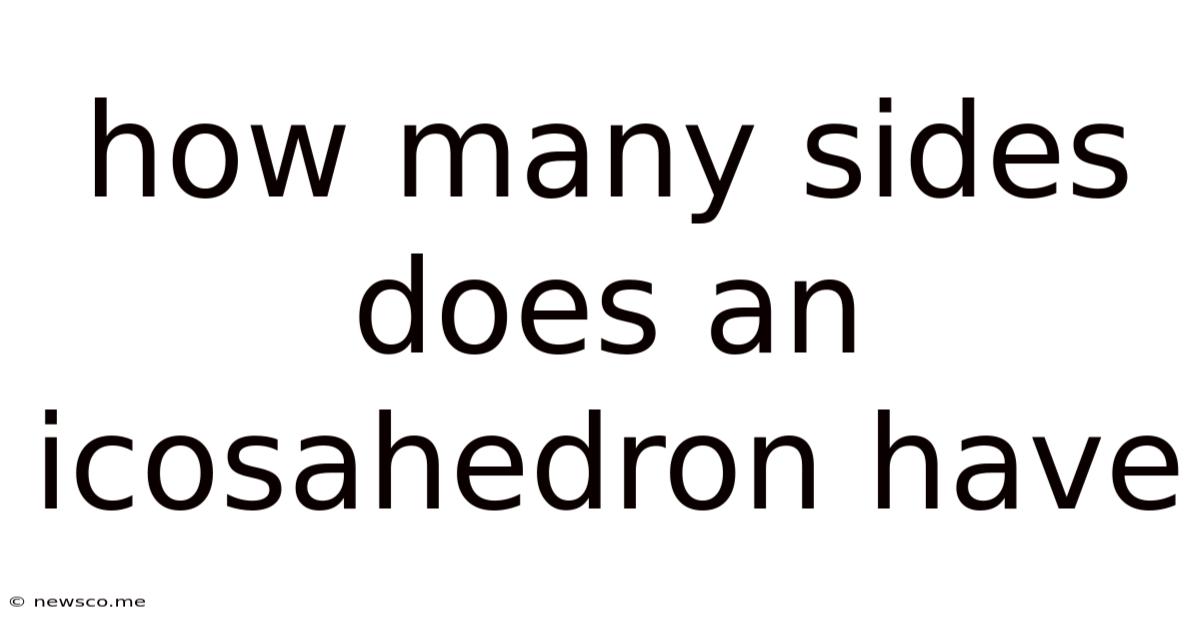How Many Sides Does An Icosahedron Have
News Co
May 08, 2025 · 4 min read

Table of Contents
How Many Sides Does an Icosahedron Have? A Deep Dive into Platonic Solids
The question, "How many sides does an icosahedron have?" might seem simple at first glance. The answer, however, opens a door to a fascinating world of geometry, exploring the properties of Platonic solids and their significance in mathematics, art, and even nature. Let's delve into the intricacies of the icosahedron, uncovering not only its number of sides but also its other defining characteristics.
Understanding the Icosahedron: Faces, Edges, and Vertices
An icosahedron is a three-dimensional shape, a polyhedron, belonging to a special class known as Platonic solids. These are convex regular polyhedra, meaning they are composed of identical regular polygons meeting at identical vertices. The defining characteristic of a Platonic solid is its uniformity: all its faces, edges, and vertices are congruent.
So, how many sides does an icosahedron have? The term "sides" in this context refers to the faces of the polyhedron. An icosahedron is composed of 20 equilateral triangles. Therefore, the answer is definitively 20.
Beyond the Faces: Edges and Vertices
While the number of faces is a key characteristic, understanding an icosahedron fully requires examining its edges and vertices.
- Faces: As established, an icosahedron has 20 triangular faces.
- Edges: Each edge is the line segment where two faces meet. An icosahedron has 30 edges.
- Vertices: A vertex is a point where three or more edges meet. An icosahedron has 12 vertices.
These numbers – 20 faces, 30 edges, and 12 vertices – are not arbitrary. They are interconnected and follow specific mathematical relationships, a testament to the elegance and inherent order of Platonic solids.
The Mathematical Elegance of Platonic Solids
The icosahedron's properties are not unique but share characteristics with the other four Platonic solids:
- Tetrahedron: 4 faces (triangles), 6 edges, 4 vertices
- Cube (Hexahedron): 6 faces (squares), 12 edges, 8 vertices
- Octahedron: 8 faces (triangles), 12 edges, 6 vertices
- Dodecahedron: 12 faces (pentagons), 30 edges, 20 vertices
Notice the interconnectedness? Euler's formula, a fundamental theorem in topology, elegantly describes this relationship: V - E + F = 2, where V represents vertices, E represents edges, and F represents faces. This formula holds true for all convex polyhedra, including the Platonic solids. Let's verify it for the icosahedron: 12 (vertices) - 30 (edges) + 20 (faces) = 2. It works!
This mathematical consistency underscores the profound significance of Platonic solids, placing them at the heart of various mathematical concepts and theories.
Icosahedra in the Real World: From Viruses to Architecture
The icosahedron's symmetrical beauty and inherent stability are not merely abstract mathematical concepts. Its structure is found reflected in various natural phenomena and human creations:
Nature's Icosahedra:
- Viruses: Many viruses, such as the common cold virus, exhibit an icosahedral structure. This shape efficiently encapsulates genetic material while minimizing surface area, a critical aspect in viral function.
- Fullerene Molecules: Certain carbon molecules, known as fullerenes (like buckminsterfullerene, also known as a "buckyball"), take on an icosahedral form. These molecules have significant applications in nanotechnology and material science.
- Radiolaria: Some radiolarians, single-celled marine organisms, have skeletons resembling icosahedra, showcasing nature's preference for efficient and stable structures.
Human-made Icosahedra:
- Architecture: Icosahedral geometry is sometimes employed in architectural designs, utilizing the structure's strength and aesthetic appeal. The inherent symmetry offers possibilities for innovative and visually stunning buildings.
- Geodesic Domes: The design of geodesic domes often incorporates icosahedral principles, creating strong and lightweight structures capable of spanning large areas. Buckminster Fuller's work popularized this architectural concept.
- Games and Puzzles: Icosahedral dice are commonly used in role-playing games. The shape's multiple faces provide a high degree of randomness.
Exploring Further: Beyond the Basics
Understanding the "how many sides" question for an icosahedron opens the door to a more profound exploration of its properties:
- Symmetry Groups: Icosahedra possess a high degree of rotational symmetry, making them fascinating subjects in group theory, a branch of abstract algebra.
- Duality: The icosahedron is dual to the dodecahedron. This means that if you connect the centers of the faces of an icosahedron, you form a dodecahedron, and vice versa.
- Stellations and Truncations: Various geometric operations, like stellation (adding points to create star-like shapes) and truncation (cutting off corners), can create visually stunning and mathematically interesting derived shapes from the icosahedron.
Conclusion: More Than Just 20 Sides
The seemingly simple question of "how many sides does an icosahedron have?" serves as a gateway to a rich and rewarding exploration of geometry, mathematics, and the natural world. The icosahedron, with its 20 triangular faces, 30 edges, and 12 vertices, embodies a beautiful synergy between mathematical elegance and practical applications. Its appearance in viruses, molecules, and architectural designs highlights its significance beyond the theoretical realm, emphasizing its enduring importance across multiple disciplines. So, remember, the answer is 20, but the implications are far more extensive.
Latest Posts
Latest Posts
-
How Much Is 25 Off Of 40
May 08, 2025
-
This Is The Metric Unit For Measuring Volume
May 08, 2025
-
How To Find The Bases Of A Trapezoid
May 08, 2025
-
Is Square Root The Same As 1 2 Power
May 08, 2025
-
Algorithm For Converting Decimal To Binary
May 08, 2025
Related Post
Thank you for visiting our website which covers about How Many Sides Does An Icosahedron Have . We hope the information provided has been useful to you. Feel free to contact us if you have any questions or need further assistance. See you next time and don't miss to bookmark.